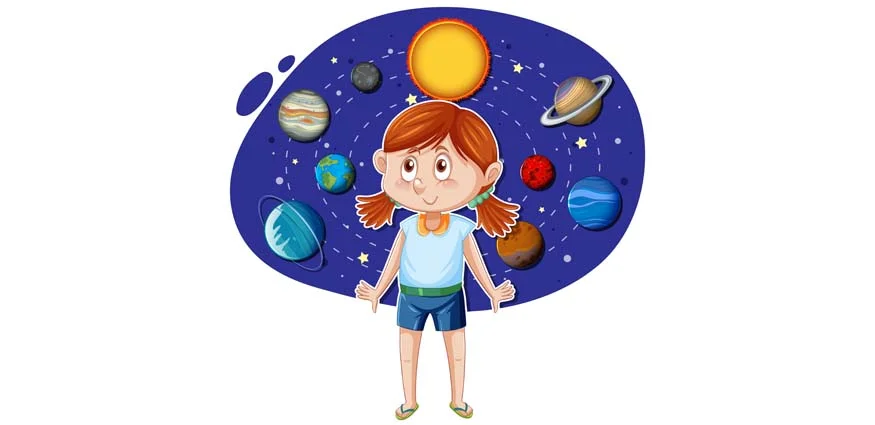The solar system is incredible. If your kids love space, these DIY solar system projects let them explore science at home. Check out these fun projects that mix science with enjoyment, making the wonders of the cosmos come alive for young explorers.
- Model solar system project
- Styrofoam balls of various sizes
- Wooden skewers or dowel rods
- Paint and brushes
- Glue or tape
- Pictures of planets for reference
- Large sheet of cardboard or foam board
- Utilise the Styrofoam balls to depict both the sun and the planets. Paint each ball to imitate the appearance of the specific planet, referring to the photos as a guide.
- Once the paint dries, you can assemble your solar system. Start by glueing the sun in the centre of the cardboard.
- Cut the skewers to different lengths – each length representing the distance of each planet from the sun. Then, attach the planets to their corresponding skewers.
- Place the planets on the skewers around the sun in the right order, starting from the inner and going to the outer solar system.
- Solar system poster project
- Large poster board
- Markers or coloured pencils
- Space-themed stickers or cut-outs
- Glue or tape
- Ruler or straight edge
- Sketch out the sun and the planets on the poster board, using a ruler to ensure proper alignment and scale.
- Colour each planet, adding details like rings and colour variations.
- Write each planet’s name by its picture and add cool facts, such as how many moons or what its atmosphere is like.
- Make the poster look fun with space stickers, stars, comets, asteroids, and more.
- Solar system project with Papier Mache planets
- Balloons
- Newspaper
- Papier Mache paste (glue, water, and flour)
- Paint and brushes
- String or fishing line to hang planets
- Blow up balloons of different sizes for planets, using a larger one for the sun.
- Rip newspaper into strips, dip it in paste and cover the balloons.
- Let them dry, then paint them to look like the sun and planets.
- Hang the planets at different heights to make a three-dimensional solar system.
- Digital solar system project
- Computer with Internet access
- Solar system simulation software or online tools (like Solar System Scope or Universe Sandbox)
- Familiarise yourself with the software and understand how it displays the solar system.
- Arrange the planets in order, adjust the solar system’s appearance, and simulate planetary orbits using the available tools.
- Record the simulation through screen recording to create a video or capture screenshots for use in a presentation.
- Solar system project with recyclable materials
- Recyclable materials (plastic bottles, lids, cardboard)
- Paint and brushes or markers
- Glue or tape
- String or fishing line for hanging
- Choose recyclable materials that can be transformed into planets and the sun. For example, consider using bottle lids for small planets and larger plastic bottles for the sun or gas giants.
- Decorate or paint them to imitate the celestial bodies in the solar system.
- Attach string or line and hang the recycled planets to display the model.
- Solar system project with flashcards
- Coloured index cards or cardstock paper
- Markers or coloured pens
- Solar system stickers or printed images of planets
- Glue or double-sided tape
- Scissors
- Solar system facts or information to write on the cards (optional)
- Cut the coloured index cards or cardstock paper into small, uniform rectangles to serve as flashcards.
- On each card, draw or colour symbols that represent each planet in our solar system. For example, a ring for Saturn, a red dot for Mars, etc.
- If you have solar system stickers or printed images of planets, attach them to the corresponding flashcards. Use glue or double-sided tape to secure them neatly.
- Write the name of each planet beneath its symbol or image.
- Write interesting facts about each planet on the back of the flashcards. This can include details about size, composition, or any fun facts.
- Fizzy Solar System project
- Baking soda
- Vinegar
- Food colouring (various colours)
- Small bowls or cups
- Measuring spoons
- Tray or baking sheet
- Craft sticks or spoons for stirring
- Cardstock or construction paper
- Marker
- Small containers for planets (optional)
- Cut circles from paper to represent planets.
- Mix baking soda with food colouring in small bowls or cups.
- Place the circular planet shapes on a tray or baking sheet.
- In separate bowls or cups, pour vinegar. You can add a different colour to each bowl to correspond with the colours of your fizzy mixtures.
- Dip, sticks or spoons into the fizzy mix and touch them to the planets. When vinegar meets baking soda, colourful bubbles appear.
Materials:
Steps:
Also Read: Mind-Blowing Science Projects for 7th Graders
Materials:
Steps:
Papier Mache provides a tactile experience for children, and making planets can be both fun and messy – a perfect combination for engaging with science.
Materials:
Steps:
Also Read: Kindergarten Science Activities & Experiments
For a modern take on the solar system project, kids can use various software programs to create digital representations of the solar system.
Materials:
Steps:
Materials:
Steps:
Materials:
Steps:
Also Read: Science Experiments Every Primary Student Should Know
Materials:
Steps:
Engaging in solar system projects is an excellent method for kids to discover and understand more about space. It helps them see how vast space is and what makes each planet different. These projects let kids explore basic space ideas and make them like the universe even more.
For more such interesting blogs, Visit EuroSchool









